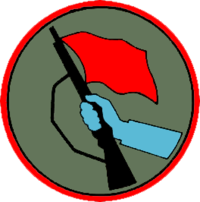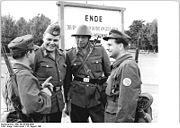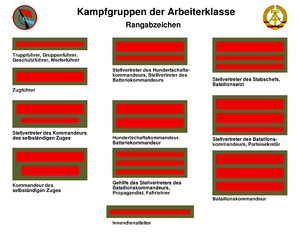
Combat Groups of the Working Class
Encyclopedia

German language
German is a West Germanic language, related to and classified alongside English and Dutch. With an estimated 90 – 98 million native speakers, German is one of the world's major languages and is the most widely-spoken first language in the European Union....
: Kampfgruppen der Arbeiterklasse, KdA) was a paramilitary
Paramilitary
A paramilitary is a force whose function and organization are similar to those of a professional military, but which is not considered part of a state's formal armed forces....
organization in East Germany, founded in 1953 and abolished in 1990. It numbered about 400,000 volunteers for much of its existence.
History

Uprising of 1953 in East Germany
The Uprising of 1953 in East Germany started with a strike by East Berlin construction workers on June 16. It turned into a widespread anti-Stalinist uprising against the German Democratic Republic government the next day....
of June 1953. The KdA made its first public appearance at the annual May Day demonstration on May 1, 1954. It was intended to be the East German equivalent to the People's Militias
People's Militias (Czechoslovakia)
People's Militias was a militia organisation of Communist Party of Czechoslovakia during between 1948 and 1989.- History :...
of Czechoslovakia
Czechoslovakia
Czechoslovakia or Czecho-Slovakia was a sovereign state in Central Europe which existed from October 1918, when it declared its independence from the Austro-Hungarian Empire, until 1992...
which played a very important part in the Communist consolidation of power in Czechoslovakia in 1948. Their formation also fit the East German ethos of the worker being the centre of power in the new Communist state.
A central school for KdA leaders was set up in Schmerwitz in 1957. Der Kämpfer was the monthly newspaper and voice of the KdA; it was printed by the SED's Neues Deutschland
Neues Deutschland
Neues Deutschland is a national German daily newspaper. It was the official party newspaper of the Socialist Unity Party of Germany , which governed the German Democratic Republic , and as such served as one of the party's most important organs...
publishing house.
The largest use of the KdA was during the construction of the Berlin Wall
Berlin Wall
The Berlin Wall was a barrier constructed by the German Democratic Republic starting on 13 August 1961, that completely cut off West Berlin from surrounding East Germany and from East Berlin...
in the summer and fall of 1961. The best trained and most politically reliable KdA units and members from Saxony, Thuringia and East Berlin participated in the construction and guarding of the Wall. Over 8,000 KdA, about 20% of all military units, were involved in this effort. During the six week deployment of the KdA to the East-West Berlin sector boundary, only eight members escaped to the West, indicating a high state of morale and political reliability.
The KdA were not used during the peaceful mass protests in late 1989 at the Nikolaikirche in Leipzig
Leipzig
Leipzig Leipzig has always been a trade city, situated during the time of the Holy Roman Empire at the intersection of the Via Regia and Via Imperii, two important trade routes. At one time, Leipzig was one of the major European centres of learning and culture in fields such as music and publishing...
as many KdA members identified with the protesters and some participated in the marches. The decline of the Socialist Unity Party
Socialist Unity Party of Germany
The Socialist Unity Party of Germany was the governing party of the German Democratic Republic from its formation on 7 October 1949 until the elections of March 1990. The SED was a communist political party with a Marxist-Leninist ideology...
(SED) and rapid political changes in East Germany after the Wall was opened made the KdA no longer relevant or necessary. The decision to disband the KdA was made by the East German parliament (Volkskammer
Volkskammer
The People's Chamber was the unicameral legislature of the German Democratic Republic . From its founding in 1949 until the first free elections on 18 March 1990, all members of the Volkskammer were elected on a slate controlled by the Socialist Unity Party of Germany , called the National Front...
) in December 1989. Disarmament of the KdA began that month and was supervised by the police who consolidated and stored weapons and equipment along with the National People's Army
National People's Army
The National People’s Army were the armed forces of the German Democratic Republic .The NVA was established in 1956 and disestablished in 1990. There were frequent reports of East German advisors with Communist African countries during the Cold War...
(NVA). The final 189,370 fighters (in 2,022 units) were completely demobilized in May 1990.
Aid to other countries
There are indications that the KdA was involved in East German military aid to Africa. On May 23, 1980, Radio Brazzaville reported the visit of a KdA delegation in Brazzaville, Republic of Congo. The KdA delegation had announced they were willing to train Congolese people's militiamen in East Germany as well and supply them with equipment.Command and control
The KdA fell under the authority of the Central Committee (Zentralkomitee) (ZK) of the SED. The KdA was the political-military instrument of the SED; it was essentially a "party Army". All KdA directives and decisions were made by the ZK's PolitbüroPolitburo
Politburo , literally "Political Bureau [of the Central Committee]," is the executive committee for a number of communist political parties.-Marxist-Leninist states:...
. The ZK also supervised the rest of the armed forces through its security commission (Sicherheitskommission).
The ZK exercised this power through two chains-of-command. The first ran through the Ministry of the Interior and the People's Police (Volkspolizei
Volkspolizei
The Volkspolizei , or VP, were the national police of the German Democratic Republic . The Volkspolizei were responsible for most law enforcement in East Germany, but its organisation and structure were such that it could be considered a paramilitary force as well...
), which provided military training, equipment and operational expertise. Second was through the SED district (Bezirk) and county (Kreis) directorates in the areas of personnel and political suitability of members.
Commanders of battalions and companies Hundertschaften were appointed by the Party organization in the major factories or enterprises in the area. They were confirmed by the SED county leadership (Kreisleitung) which received regular reports on the state of training, equipment and membership.
Membership
By 1989, the KdA's membership totaled approximately 210,000 including approximately 187,000 active members and the remainder in reserve. Recruitment was accomplished by the party branches in the factories and enterprises. Membership was voluntary, but SED party members were required to join as part of their party obligation. Non-party members were compelled to join by the Free German Trade Union FederationFree German Trade Union Federation
The Free German Trade Union Federation, in German Freier Deutscher Gewerkschaftsbund , was the trade union federation in East Germany. It was part of the National Front and had representatives in the Volkskammer....
(FDGB). Men between the ages of 25 to 60 were eligible for membership. Younger men, if they were not performing military service, were part of the Paramilitary Society for Sport and Technology (GST). The KdA also had a large number of women who were mainly used in the medical and supply services.
Organization
The KdA were organized into units based on their workplace. General units were closely tied to their local based nationalized enterprises, state and local administration offices and other workplaces, and their organizations and their employment did not extend beyond the district level. The mobile or motorized units, designated Battalions of the Regional Reserve, could be employed outside their local and district areas.The organization was similar to the United States National Guard
United States National Guard
The National Guard of the United States is a reserve military force composed of state National Guard militia members or units under federally recognized active or inactive armed force service for the United States. Militia members are citizen soldiers, meaning they work part time for the National...
or British Territorial Army; however, unlike a national guard or territorial army, the KdA was strictly controlled by the governing SED.
Each large factory
Factory
A factory or manufacturing plant is an industrial building where laborers manufacture goods or supervise machines processing one product into another. Most modern factories have large warehouses or warehouse-like facilities that contain heavy equipment used for assembly line production...
, along with many neighbourhoods, had their own Kampfgruppe, each made up of about 100 workers who sought to "defend the property
Property
Property is any physical or intangible entity that is owned by a person or jointly by a group of people or a legal entity like a corporation...
of the people". The KdA were organised like infantry
Infantry
Infantrymen are soldiers who are specifically trained for the role of fighting on foot to engage the enemy face to face and have historically borne the brunt of the casualties of combat in wars. As the oldest branch of combat arms, they are the backbone of armies...
, and were to supplement the military
Military
A military is an organization authorized by its greater society to use lethal force, usually including use of weapons, in defending its country by combating actual or perceived threats. The military may have additional functions of use to its greater society, such as advancing a political agenda e.g...
and police
Police
The police is a personification of the state designated to put in practice the enforced law, protect property and reduce civil disorder in civilian matters. Their powers include the legitimized use of force...
serving as security in rear areas during wartime or in political emergencies
State of emergency
A state of emergency is a governmental declaration that may suspend some normal functions of the executive, legislative and judicial powers, alert citizens to change their normal behaviours, or order government agencies to implement emergency preparedness plans. It can also be used as a rationale...
, such as protest
Protest
A protest is an expression of objection, by words or by actions, to particular events, policies or situations. Protests can take many different forms, from individual statements to mass demonstrations...
s against the government.
Training and equipment
Training was conducted by the People's Police (VolkspolizeiVolkspolizei
The Volkspolizei , or VP, were the national police of the German Democratic Republic . The Volkspolizei were responsible for most law enforcement in East Germany, but its organisation and structure were such that it could be considered a paramilitary force as well...
) to avoid the KdA being counted as part of the total strength of the armed forces under international treaties. The KdA also provided economic savings to the SED which didn't have to construct barracks for these forces, whose members continued their civilian work while training in their spare time. A KdA member trained with his group after work and on weekends for a total of 136 hours annually. KdA training camps were held annually, usually in the wilderness.
The KdA had at their disposal many of the weapons that the police would use in riot situations, and also SK-1 armoured car
Garant 30k SK-1
The Garant 30k SK-1 better known as the SK-1 was an East German armored patrol vehicle was used only by the Alert Police of the East German Police and not used by the East German Army. Though similar in appearance to the Russian BA-64, the SK-1 is an independent development and much bigger than the...
s, SK-2 water cannon (both armoured and unarmoured versions), 82mm mortars; 76mm antitank guns; and 23mm and 37mm antiaircraft guns. In terms of infantry weapons, the KdA were armed with both World War II German and Soviet infantry weapons during the 1950s and 1960s e.g. the Mauser Kar98k rifle
Karabiner 98k
The Karabiner 98 Kurz was a bolt action rifle chambered for the 8x57mm IS/7.92×57mm IS cartridge that was adopted as the standard service rifle in 1935 by the German Wehrmacht. It was one of the final developments in the long line of Mauser military rifles...
, the Mosin-Nagant rifle
Mosin-Nagant
The Mosin–Nagant is a bolt-action, internal magazine-fed, military rifle invented under the government commission by Russian and Belgian inventors, and used by the armed forces of the Russian Empire, the Soviet Union and various other nations....
, and the PPSh-41
PPSh-41
The PPSh-41 was a Soviet submachine gun designed by Georgi Shpagin as an inexpensive, simplified alternative to the PPD-40. Intended for use by minimally-trained conscript soldiers, the PPSh was a magazine-fed selective-fire submachine gun using an open-bolt, blowback action...
submachine gun. In later years, they would be re-equipped with modern small arms like the AKM
AKM
The AKM is a 7.62mm assault rifle designed by Mikhail Kalashnikov. It is an upgraded version of the AK-47 rifle and was developed in the 1950s....
rifle.
Ranks

- Truppführer/Gruppenführer/Geschützführer/Werferführer - squad leader/group leader/cannon leader/ejector leader,
- Zugführer - platoon leader
- Stellvertreter des Kommandeurs des selbständigen Zuges - deputy leader of the independent platoon
- Kommandeur des selbständigen Zuges -leader of the independent platoon
- Stellvertreter des Hundertschaftskommandanten, Stellvertreter des Batteriekommandanten - deputy of a company commander, deputy leader of an artillery battery
- Hundertschaftskommandeur, Batteriekommandeur - company commander, (artillery) battery commander
- Gehilfe des Stellvertreters des Bataillonskommandeurs, Propagandist, Fahrlehrer - adjutant of the deputy battailon leader, propagandist, driving instructor
- Stellvertreter des Stabschefs, Bataillonsarzt - deputy chief of staff, battalion's physician
- Stellvertreter des Bataillonskommandeurs, Parteisekretär - deputy battalion commander, party secretary
- Bataillonskommandeur - battalion commander
- Innendienstleiter - duty officer
Badges, awards and insignia
There were a series of badges as well as service and merit medalMedal
A medal, or medallion, is generally a circular object that has been sculpted, molded, cast, struck, stamped, or some way rendered with an insignia, portrait, or other artistic rendering. A medal may be awarded to a person or organization as a form of recognition for athletic, military, scientific,...
s awarded to KdA members. The KdA also wore distinctive red rank insignia on the right arm of their uniform.
Oath of the combat groups
"I am ready, as a fighter of the Working Class to fulfill the directives of the Party to defend the German Democratic Republic and its Socialist achievements at any time with my weapon in my hand and to lay down my life for them. This I swear."..See also
- National People's ArmyNational People's ArmyThe National People’s Army were the armed forces of the German Democratic Republic .The NVA was established in 1956 and disestablished in 1990. There were frequent reports of East German advisors with Communist African countries during the Cold War...
- Eastern Bloc politicsEastern Bloc politicsEastern Bloc politics followed the Red Army's occupation of much of eastern Europe at the end of World War II and the Soviet Union's installation of Soviet-controlled communist governments in the Eastern Bloc through a process of bloc politics and repression...

